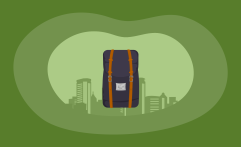How To Make Ethical Soap: The Complete Guide
Impactful Ninja is reader-supported. When you buy through links on our site, we may earn an affiliate commission.
Learn more
Learn more
.
Hey fellow impactful ninja ? You may have noticed that Impactful Ninja is all about providing helpful information to make a positive impact on the world and society. And that we love to link back to where we found all the information for each of our posts. Most of these links are informational-based for you to check out their primary sources with one click. But some of these links are so-called "affiliate links" to products that we recommend. First and foremost, because we believe that they add value to you. For example, when we wrote a post about the environmental impact of long showers, we came across an EPA recommendation to use WaterSense showerheads. So we linked to where you can find them. Or, for many of our posts, we also link to our favorite books on that topic so that you can get a much more holistic overview than one single blog post could provide. And when there is an affiliate program for these products, we sign up for it. For example, as Amazon Associates, we earn from qualifying purchases. First, and most importantly, we still only recommend products that we believe add value for you. When you buy something through one of our affiliate links, we may earn a small commission - but at no additional costs to you. And when you buy something through a link that is not an affiliate link, we won’t receive any commission but we’ll still be happy to have helped you. When we find products that we believe add value to you and the seller has an affiliate program, we sign up for it. When you buy something through one of our affiliate links, we may earn a small commission (at no extra costs to you). And at this point in time, all money is reinvested in sharing the most helpful content with you. This includes all operating costs for running this site and the content creation itself. You may have noticed by the way Impactful Ninja is operated that money is not the driving factor behind it. It is a passion project of mine and I love to share helpful information with you to make a positive impact on the world and society. However, it's a project in that I invest a lot of time and also quite some money. Eventually, my dream is to one day turn this passion project into my full-time job and provide even more helpful information. But that's still a long time to go. Stay impactful,Affiliate Disclosure
Why do we add these product links?
What do these affiliate links mean for you?
What do these affiliate links mean for us?
What does this mean for me personally?
![]()
Shopping for ethical and sustainable soap isn’t always easy. You have to do your homework to find out if products are organic or vegan, tested on animals, contain sustainable palm oil…it’s just too much. Instead, we suggest you save yourself from such investigations and make ethical soap yourself. But we had to ask: How to make ethical soap?
You can make ethical soap out of natural oils, water, and lye. Use a slow cooker for a hot-process soap that cures in a few days. No cooking is required for a cold-process soap, but it can take several weeks to cure. Pre-made soap bases can also be used to make melt-and-pour soap.
We’ve got the complete guide on how to make ethical soap that is eco-friendly, sustainable, and, yes, vegan. We even have soap you can make without using lye! So if you’re tired of playing ethics detective every time you need to buy soap, read this article and learn how to make your own instead.
Choose Your (Ethical, Sustainable, Organic, Eco-Friendly) Ingredients
To make “true soap,” only three things are required: oil, water, and, yes, lye. Let’s have a look at them one after the other. (Ok, minus the water, but we’ll add some bonus ingredients instead.)
Start with Picking the Oil Base You Prefer for Your Ethical Soap
The biggest advantage of making your own ethical soap at home is that you can put just about anything you want into it. Beyond the required three ingredients, you can add stuff like turmeric for color, essential oils for scent, exfoliants for texture, even seashells for aesthetics, if so desired.
Plus, you can create a homemade organic soap for a much lower cost than store-bought options and use high-quality organic ingredients of your choosing.
The main and most important ingredients are the oils and other fats you use. Some popular options generally favored by many soap makers include:
- Olive Oil
- Avocado Oil
- Coconut Oil
- Cocoa Butter
- Shea Butter
- Castor Oil
- Mango Butter
You may also decide to add essential oils to give your soap a nice scent or therapeutic quality. For example, lavender has a very floral scent and a calming effect. Citrus options like orange or lemon have bright, fruity smells that help energize.
Add the Amount of Lye for Your Soap Based on Your Oil Base
Anyone who has seen Fight Club knows about the potential dangers of this lye. But using lye to make soap is an age-old process, and there is not much to fear once you are informed.
Lye is also known by its common name, sodium hydroxide. That’s right: lye is a salt compound. (It doesn’t sound that scary anymore, does it?)
And as far as its role in soap making goes, lye is considered a reagent in the recipe. That means that it is used to create a chemical reaction with the other substances. Blending natural oils with a carefully measured water and lye mixture will trigger a reaction or process known as saponification. Essentially, this process is what cures or solidifies a soap mixture into a bar.
Nonetheless, there are some words of caution that I want to share with you first:
- Lye is indeed a caustic substance if it comes in contact with your skin. That means it can burn, corrode, or otherwise destroy living tissue. Also, the fumes generated by mixing lye with water are caustic to your mucous membranes and eyes. Furthermore, if you ingest lye, you could die.
- For these reasons, it is imperative that you use personal protection when using lye. Gear such as a mask, goggles, and heat-resistant gloves are required to protect your eyes, nose, and hands, and it is recommended to wear well-fitting (not loose or hanging) clothes that fully cover your body to minimize skin exposure. Also, be sure to work in a very well-ventilated area.
- We recommend keeping unused lye in a locked or high-up cabinet and away from small children (or curious pets).
But it is also important to know that soap will not have unreacted lye remaining when it is made properly. So you have nothing to worry about in using this critical component to make soap so long as you do not handle it carelessly.
And when it comes to lye, it is important that you calculate how much you need – based on the type and amount of oil you chose (and the water to add). Why is this step so crucial in the soap making process?
- That’s because each variety of oil requires a particular amount of lye to catalyze saponification, and each oil has its own saponification rate or sap rate.
- So a different amount of lye is needed for each oil you choose.
- Then, once you start mixing oils together, you must take each oil’s sap rate and use a few equations to determine how much lye is needed for every unique soap recipe.
The Sage has a Lye Calculator that is pretty straightforward. It’s easy to use with a clean, simple layout, and there are additional instructions on how to use the tool and understand the results. (Further down in this post, we share more advanced lye calculators too)
Anytime you use a new recipe, it is good to verify the lye amounts with a calculator, even if the recipe comes from a trusted source. (Typos happen, you know.) Additionally, if you ever tweak or modify a recipe for any reason, you will need to use a calculator. Even a single ounce of one oil over another can make a difference in how much lye will be needed.
Choose Any Additional Ingredients or Even Colors to Add
Of course, if you want to get artisanal with your soap, you can always add color or texture or mold it into a unique shape. (However, as a beginner, you will want to master some basic soap recipes before adding these details.)
And you can also color your homemade soaps with natural ingredients like carrots, avocados, spinach, hibiscus, daffodils, clay, wood…again, just about anything can go into soap! Of course, the bonus to natural ingredients is that you have a soap that doesn’t harm your skin.
The Equipment Needed to Make Your Own Ethical Soap
Soap recipes typically list ingredient measurements in weight instead of volume, and a digital kitchen scale will be required to portion your ingredients properly. If you plan to make hot process soap, a slow cooker is recommended. You could use the stove-top or a hot plate, but these methods require close and constant attention to keep the soap mixture from overheating. Bubbles act like volcanos if they are not stirred down, which will splatter soap all over.
In addition to a digital scale and slow cooker, you will need:
- Multiple glasses or stainless steel bowls/jars for mixing and measuring (do not use aluminum because it will react to the chemicals)
- Stick blender
- Metal spoon
- Wooden spoon
- Spatula
- Soap molds (a baking pan or cardboard box lined with parchment paper will do fine if you don’t have dedicated molds.)
- Gloves, eyewear, and other protective gear for handling lye
- White vinegar (for neutralizing anything the lye mixture touches–keep nearby in case of accidental lye spills)
Many homemade soap-making sources say that it’s okay to use your regular, everyday kitchen equipment to make soap provided you carefully wash it afterward and neutralize anything that was used for lye. And you certainly can.
However, if you plan to incorporate soap making into your lifestyle, not just do it once or twice for fun, then you should get separate equipment that is only used for making soap to eliminate any possibility of contaminating things you use for food with soap and chemicals.
Hot Process or Cold Process: What’s the Difference?
The distinction between these two methods is, as the names suggest, whether heat is used in the process or not. In both methods, a lye and water mixture together with oils are combined and go through the saponification process.
When using a cold process, soap is poured into insulated molds, and the saponification process can take several weeks.
Using a hot process requires the additional step of “cooking” your soap mixture. The heat will quicken the saponification process, allowing soap to be ready in just a few days.
Both methods work equally as well, just one is slower, and one is faster. And based on personal experience, we recommend you using the slow cooker.
Let’s have a look at our favorite soap recipe for this next!
How To Make Vegan Soap Using a Slow Cooker
This recipe uses an equal mix of coconut oil and olive oil, but it makes a pure and true castile soap (named for the Spanish region) when made with all olive oil. It is incredibly moisturizing, but it takes longer to cure.
Prep Time: 30 – 45 minutes
Cook Time: 35 minutes
Waiting Time: 1 day
Ingredients:
- 16 oz olive oil
- 16 oz coconut oil (this needs to be melted before portioned if it is in a solid-state)
- 12.16 oz water
- 4.844 oz lye
- 1 oz essential oils (optional)
Instructions:
- Prep your molds so that they are waiting for you when you’re ready for them. Silicone molds can be used as they are, but anything else will need to be lined wax paper, freezer paper, or garbage bag.
- Set up and clean a well-ventilated work area (that is away from children).
- Using a digital scale, weigh out 16 oz of each oil and pour them into your slow cooker.
- Turn your slow cooker on high. Once the oils begin to heat up, reduce heat to low.
- Measure out the water and lye while the oils are warming. Use separate containers for each.
- Bring the containers of measured lye and water to a well-ventilated area along with a third container at least one quart in size. Transfer the water into the third container.
- Using eye gear and gloves, slowly pour the lye into the water. NOTE: NEVER ADD WATER TO LYE. Always do it the other way around. The chemical reaction between these two ingredients creates heat very quickly, and it is possible to cause mini-explosions that can cause serious burns. If you’re interested, the short video at the bottom of these instructions goes into the science behind this phenomenon.
- With a metal spoon, carefully stir the lye/water mixture, taking care not to make direct contact with the liquid. The temperature of the mixture will rise quickly as you stir and become cloudy looking. Allow this to sit for at least 10 minutes to cool. You can see when the mixture has cooled because it will turn clear again.
- Once the oils have heated in the slow cooker to around 120-130°F (49-55°C), slowly stir in your lye/water mixture. Immediately rinse out the containers you used for lye in the sink, and re-rinse with white vinegar to neutralize. Return to the slow cooker.
- Blend the mixture using a stick blender for about 5 minutes or until it thickens and turns opaque.
- Place the lid on your slow cooker and keep the heat on low to allow the mixture to thicken. Check on it every 15 minutes for up to an hour until it is ready. Bubbling will occur on the sides of the mixture first. The mixture is ready once it is thick enough to have bubbling across the entire surface with the sides collapsed in.
- Turn off your slow cooker and remove the inner bowl. If you wish to add scent with essential oils, do that now.
- Carefully and quickly pour or spoon the mixture into your molds. Cover with parchment paper and leave in a cool, dry place to cure for 24 hours.
- Remove soap from the molds. It is ready to be used right away, but the bar will last longer if you allow it to cure for a few more days.
Advanced Online Lye Calculators and Sap Rate References
BrambleBerry has a Lye Calculator and a fragrance calculator that are popular for many homemade soap makers and includes a vast number of oils (though there are some less-common options you may be using that are not represented on their list). Plus, as a retailer, they have just about anything you may need to make soap just a few clicks away.
LyeCalc offers you more control with its Lye Calculator by allowing you to factor in the desired final properties like hardness, creaminess, or longevity. The tool is designed for a more advanced-level soap maker, but they also offer a beginners’ Lye Calculator that walks you through the process.
Suppose you’re interested in determining these equations on your own. In that case, there are some great charts and explanations online, including one from From Nature With Love that provides good detail and a compacted explanation.
Soap Making Resource has a minimal list of oils, but it provides the characteristics each oil has in soap, making it a great resource to help beginners choose ingredients to create an ideal soap without a lot of trial and error.
You may prefer one or the other in the delivery of information for the sake of comprehension, but both have all the information you need to understand this sciencey side of soap making.
How To Make Ethical Soap Without Lye
Okay, we admit it: this DIY project isn’t really making soap as much as it is crafting soap, but it’s an easy, chemical-free option that you can do with kids. It’s known as melt-and-pour soap, and it’s a great way to practice the artistic side of soap making.
Melt-and-pour soap is made in six basic steps:
- Purchase a soap base (see below).
- Create a “recipe” of mix-ins. This could include essential oils, plant extracts, even glitter (as some child out there is bound to suggest).
- Melt soap base in the microwave or on the stove-top using a double boiler (if you are familiar with melting chocolate, this is the same technique).
- Mix-in scents and any other additional ingredients.
- Pour into molds and leave to sit (soap can take anywhere from 1 to 24 hours to harden depending on the mold’s size.
- Remove from mold and enjoy!
There are many DIY websites, crafting stores, and the like that offer pre-made “plain” soap bases. However, many options contain palm oil, and it isn’t readily known if it was sustainably sourced (and the odds are good that it wasn’t). Even the ever common glycerin might be synthetic, which can be toxic.
Unfortunately, for one reason or another, it isn’t always easy to find sources for ingredients from soap base suppliers. It is recommended that you use reputable retailers, such as BrambleBerry Handcraft Divisions (although even they lack such information on their website).
So while a premade soap base is a good way to make this project easier (and prevents your kitchen from becoming a chemistry lab), keep in mind that you will still have to do some digging to ensure that what you find is an ethical choice.
Final Thoughts
If you’re thinking about making ethical soap at home, you can do it easily with a few regular kitchen tools using natural and organic ingredients of your choosing. Be sure to be safe when handling lye, and keep plenty of white vinegar around! This is a fun project that gets easier each time you do it, and it can save you money, too!
Stay impactful,

Sources
- The Sage: Lye Calculator
- BrambleBerry: Lye Calculator and Fragrance Calculator
- LyeCalc: Lye Calculator and Recipe Creator for Soap Making
- LyeCalc: Beginner’s Calculator
- From Nature With Love: Saponification Chart
- Soap Making Resource: Saponification Table and The Characteristics of Oils in Soap
- Lovely Greens: How to Naturally Color Handmade Soap + Ingredients Chart
- The Healthy Home Economist: Glycerin. When it’s Safe and When it’s Toxic
- BrambleBerry: Soap Making Supplies




